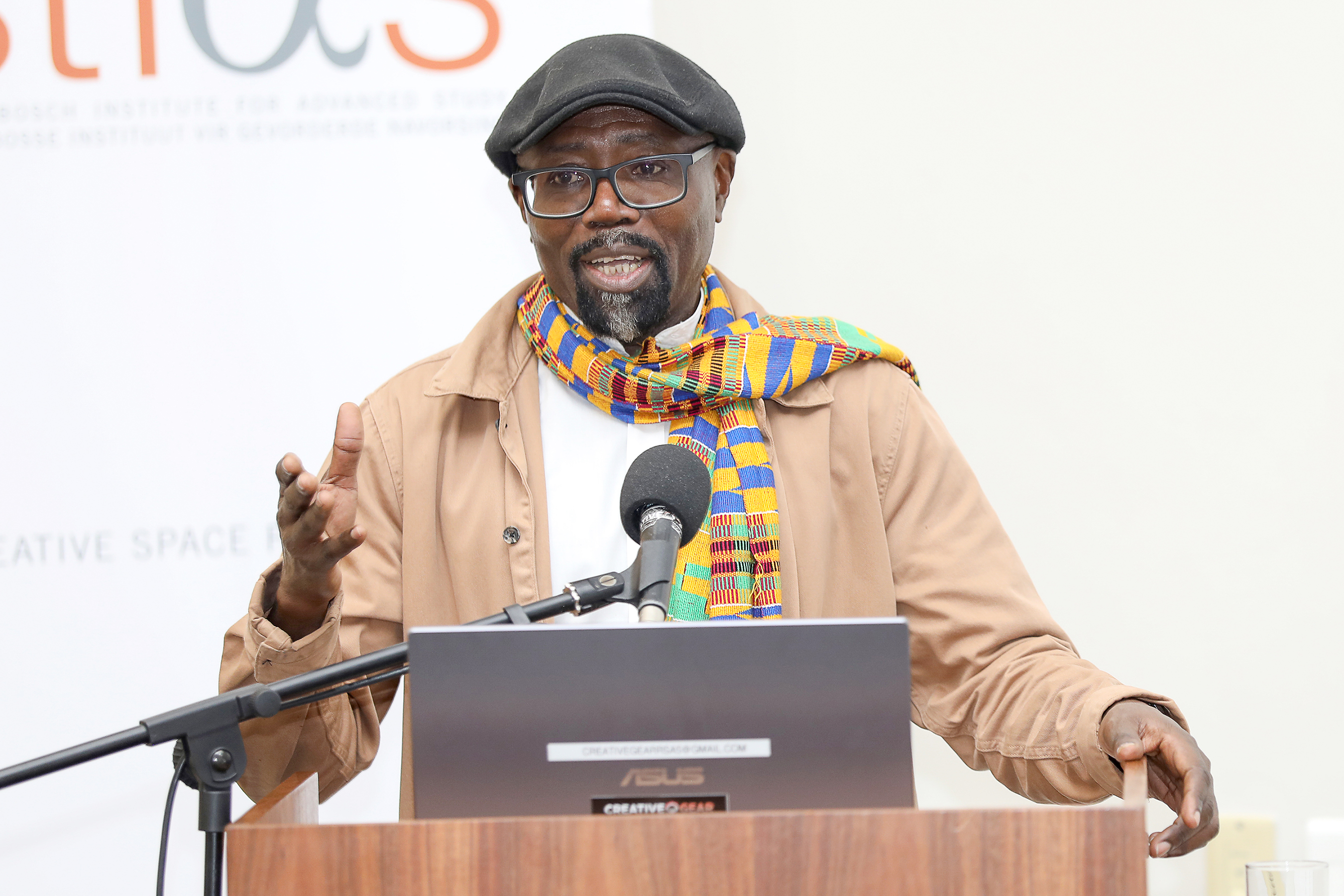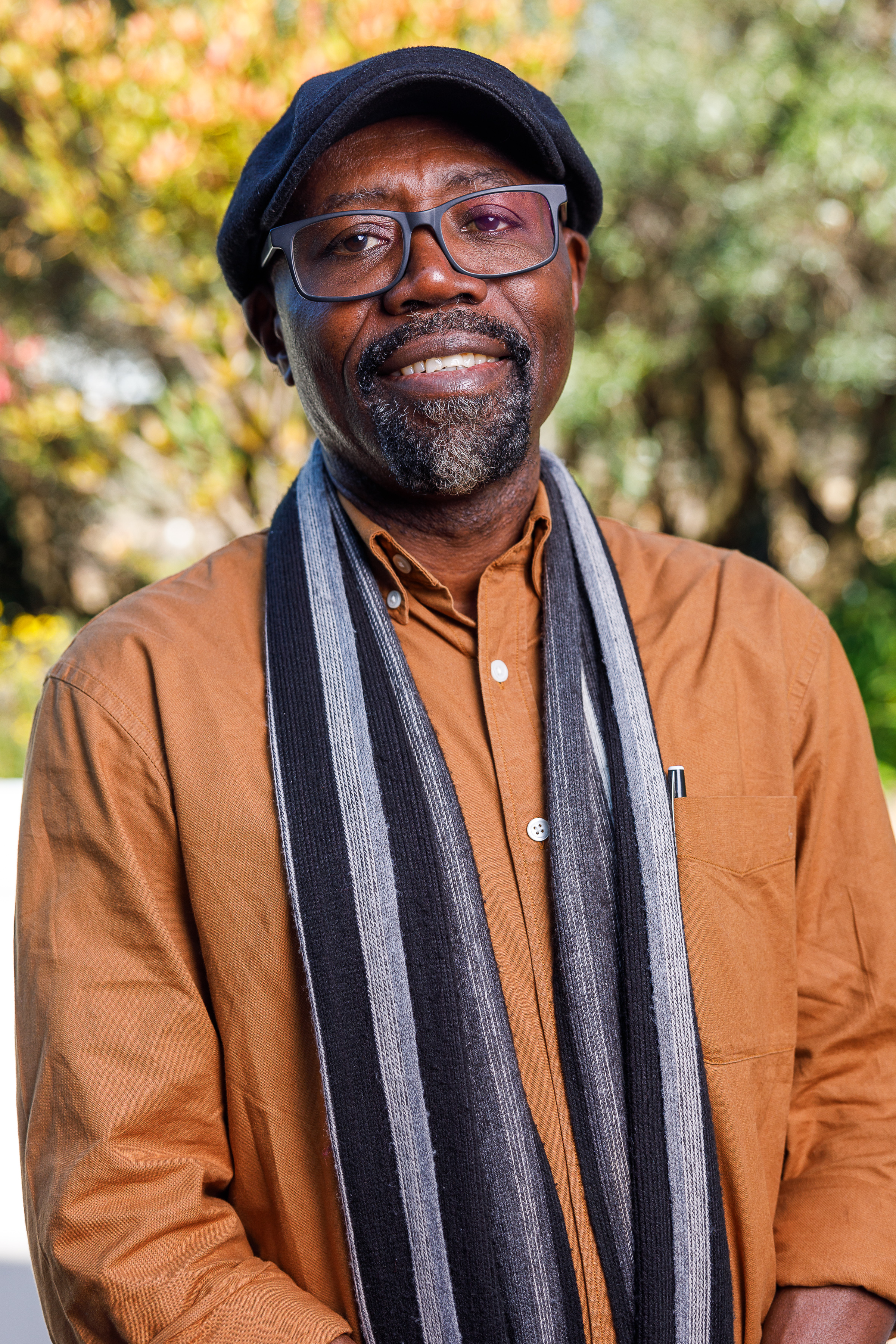“Since the mid-2000s, the East Africa region has witnessed a troubling rise in youth radicalisation, primarily driven by extremist groups like Al-Shabaab, which has connections to global terror organisations such as Al Qaeda and ISIS. The East Coast region of Kenya comprising Mombasa, Kwale, Kilifi and Lamu Counties, is the main reason for Kenya’s geo-political influence in East and Central Africa. However, the region has lagged behind economically and in terms of access to quality education. Drawing from personal experiences and a deep-rooted understanding of East African coast’s communities, The Martyr, a graphic novel, will zoom in on Kwale county specifically and unravels the complex web connecting social-economic inequality, marginalisation, radicalisation and violent extremism. It intends to interrogate the existing narratives on radicalisation and drivers of violent extremism,” explained STIAS Artist-in-Residence cartoonist Godfrey Mwampembwa, a.k.a Gado, at the second public lecture of the semester. Gado was born in Dar es Salaam, Tanzania. He is a graphic journalist and independent editorial cartoonist, animator and TV producer. His works have been published in the The East African Standard and Daily Nation (Kenya), Le Monde and Courrier International (France), Deutsche Welle (Germany) and The Continent (South Africa), among others. He is the co-founder of Buni Media, an independent multimedia company in Nairobi. [gallery size="full" ids="31491,31489,31490"] A classical animator from Vancouver Film School, Gado is also creator and producer of the weekly satirical puppet show, The XYZ SHOW, which has been running on Kenyan TV networks since 2009. He is a 2007 Prince Claus Laureate, winner of the Kenyan National Human Rights Commission, Lifetime Achievement Award in Journalism in 2018, and a recipient of the prestigious Cartoon for Peace 2016 International Editorial Cartoon Award. In 2011 Gado was among 12 leaders to receive a Visionaries Award from Ford Foundation for their innovative efforts on the frontlines of key social issues. In 2014 and 2016, he was named one of the 100 most influential people in Africa by the publication, New African. In 2022, he was awarded Chevalier dans l’ordre des Arts et des Lettres by the French government. He is a member of Cartoonists Rights Network, Cartoonists For Peace and the Kenya Union of Journalists and a 2016 Bellagio Fellow. The Martyr is his first foray into a full-length graphic novel and he explained some of the extensive background research involved and gave insights into his creative process. The Martyr will trace the story of a fictional character Bakari Mwagoza, a young Kenyan man who joins Al-Shabaab, travels to Somalia for training and returns to Kenya to commit crimes. Gado explained that Kenya has a long history of terror attacks by Al-Shabaab and other groups – the most well-known including the 1998 bombing of the US Embassy, Kikambala Hotel in 2002, the Westgate Shopping Mall in 2013, the 2015 Garissa University attack and the DusitD2 Hotel in 2019. “Mombasa is effectively the gateway to east Africa and the area contributes significantly to GDP. It’s the coast from which the slave trade was conducted with regional trade routes for centuries,” said Gado, “but, despite this, it’s a neglected, marginalised region very far from the tourist images of lovely beach resorts and hotels. Only when you visit communities in Kwale County you will have an idea of the existing poverty in the area.” Gado has conducted research and interviews in Kwale, Mombasa, Kilifi, Nairobi and Dar es Salaam but Kwale is the primary location in which he has visited seven villages. “It’s a very poor area with not much development and low education standards - most young people only have primary school education. The women are even more disadvantaged.” “I use the visits as background research for my drawing,” he said. “It’s about authenticity. It’s easy to get images online but visiting and understanding the culture gives different nuances.” He has also undertaken a series of interviews – mainly with ex-combatants of Al-Shabaab and also aspiring recruits, academics, religious and community leaders, civil-society organisations and media. “You need to spend time to build networks and trust,” he explained. “The individuals who come back obviously try to stay below the radar. They are hunted both by Al-Shabaab and by the Kenyan government authorities.” “Media reports suggest about 700 have joined Al-Shabaab but there are also suggestions that as many as 1500 have responded to the government amnesty programme.” And the government response has been as brutal as that of Al-Shabaab comprising arbitrary arrests, disappearances, harassment, extrajudicial killings and destruction of family homes and livelihoods. “I have spoken to women who lost their loved ones. There is no justice and these women did depend on their husband further exacerbating poverty.” “Many of the victims have experienced torture in the hands of security agents, they have PTSD, some end up on drugs, some shunned by their communities, and some are blacklisted for work opportunities,” he added. “There is no real help – some have been afraid to go to government programmes.” “There have been cases in the past in which people deemed collaborators, local government officials and policemen have been killed by Al-Shabaab associates. The community is caught in-between.”

The Martyr: a graphic comic novel - STIAS Public lecture by Godfrey Mwampembwa
People

